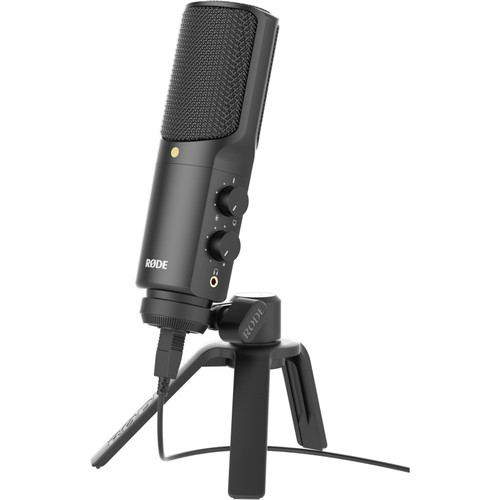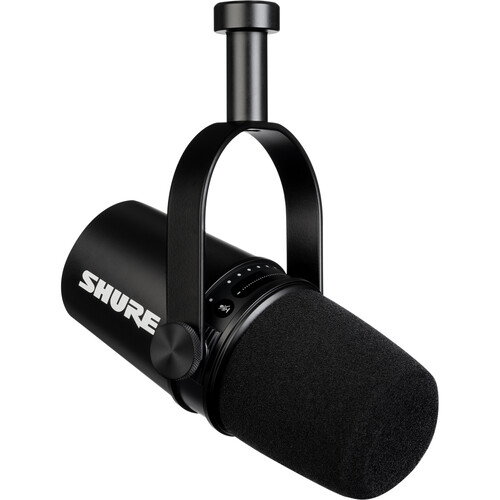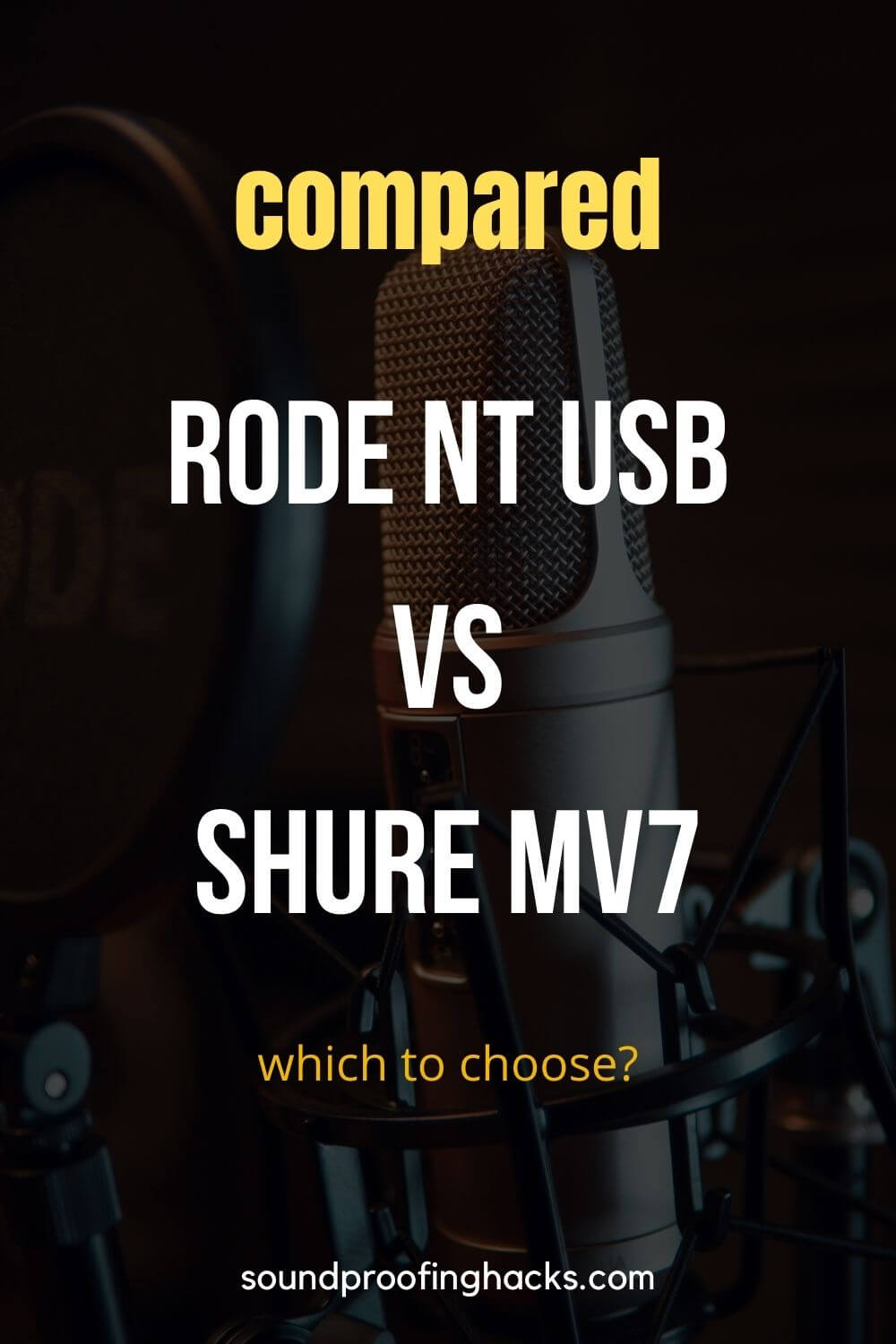RODE NT USB vs Shure MV7: The main difference between the RODE NT USB and the Shure MV7 is that the RODE NT USB is a condenser USB microphone while the Shure MV7 is a dynamic microphone. Both mics are good for voice recordings, but the MV7 does come with a wider range of functionality that would please a more advanced user.
When it comes to picking out a microphone for your studio, there are a lot of factors that can be difficult to figure out.
Microphones can be expensive and take a fair bit to figure out which suits you most. So most people don’t want to make a mistake in purchasing an unsuitable product.
I’m here to help you with this quick comparison of the RODE NT USB and Shure MV7 which I recommend for an average-level home recording studio.
| Image | Product | Features | Price |
|---|---|---|---|
 | RODE NT USB Microphone |
| Check Price |
 | Shure MV7 Microphone |
| Check Price |
When you buy through our links, we might earn a commission. Learn more in the Disclosure section.
Contents: Skip to section
Compare Rode NT USB and Shure MV7
Overview of RODE Procaster and Shure MV7
The RODE NT-USB is a high-quality USB condenser microphone for recording vocals and instruments, gaming and live streaming, podcasting, voice-overs, and other applications.
It will have you sounding like a pro in seconds, with perfect audio, exquisite appearance, and premium functionality all in an easy-to-use form factor. That includes on-board monitor level and headphone mix controls.
On the other hand, the Shure MV7 is a dynamic cardioid microphone designed for podcasting and home studio use. Shure created the MV7 as a digital audio overhaul of the iconic SM7B professional broadcasting microphone in 2020. Rolling Stone named the MV7 the best podcasting microphone in their 2021 Audio Awards.
The MV7 can broadcast its audio signal through a USB cable to a Macintosh or Windows computer, as well as to Android or iOS smartphones, and is designed to be installed on a stand or boom arm. Motiv, a free-to-use proprietary software application designed to simplify the recording or streaming procedure for each operating system, is provided by Shure to supplement the microphone’s capabilities.
Let’s jump in to find out more about the individual brands.
About the RODE NT USB
The Rode NT-USB provides all of the functionality you’ll need to record any vocal track or acoustic instrument in excellent quality. While recording vocals, the pop filter can be quickly positioned in front of the microphone, and thanks to its sensitivity and frequency response, it can pick up on all of the subtleties of an acoustic instrument’s performance.
For voiceovers, the Rode is simple to utilize. You can fine-tune what you hear in your headphones while recording because it contains a built-in headphone connector with volume control and a monitor-mix knob.
The Rode can also be used for podcasting, Skype, and gaming. It lends itself to interacting with others whether it is gaming or chatting thanks to the headphone port.
If you intend to use it for interviews though, it would be better for individuals only as the mic is side-addressed and only has one pickup pattern (cardioid), making it less suitable for an interview or group discussion than other mics (such as the Blue Yeti). It also lacks a figure-8 or omni option to do that.
- Crisp, clear, DSP-free mic signal
- Zero-latency monitoring mode
- Easy to use
- Good audio quality
- Built-in headphone output
- Fixed pattern
- No gain knob
- Only one polar pattern
- Picks up table knocks and keystrokes
- Unsteady tripod
About Shure MV7
The MV7 is a dynamic microphone with USB and XLR outputs for use with computers and professional interfaces.
It is inspired by the renowned SM7B.
You can connect via USB and use its ShurePlusTM MOTIV app’s additional set-up options and Auto Level Mode to manage your vocal tone and distance from the microphone.
Not only that, you can also allow the microphone to do the job for you with Auto Level Mode.
- Excellent dynamic mic for vocals
- USB (digital) and XLR (analog) connections
- Shure Motiv app provides real-time EQ and basic controls while recording
- Small and sturdy for easy mounting
- Exceptional vocal reproduction
- It's a set-it-and-forget interface.
- To use all of the capabilities, you'll need to download many pieces of software
- If you wish to record instruments, you'll need to make adjustments
- When recording outside in a crowded area, some unwanted noise is captured
RODE NT USB vs Shure MV7 comparison
In this section, we will compare the 2 models based on a few factors:
- Design
- Connectivity
- Sound and quality
Design
The RODE NT USB mic is larger and chunkier in person than some of the photos suggest, and its metal construction has the same high-quality feel as Rode’s other studio mics.
The side-address capsule appears to be about an inch in diameter, with a fixed cardioid pattern, and is almost certainly a back-electret type.
Although there are some visible differences, the Shure MV7 borrows a lot of design influences from the Shure SM7B.
The MV7 is smaller, with a front windshield that lifts out to reveal the microphone beneath.
The windscreen’s looseness is concerning, but it can only be removed with a strong tug.
Connectivity
I tested the Rode NT-USB on both a Mac and a PC, and it performed really well on both.
On a PC or a Mac, simply plug into an available USB port to get started.
Rode claims that the NT-USB is completely compatible with the Apple iPad for use with RODE Rec, GarageBand, and other audio programs, but unfortunately, I did not test that out. (FYI, to achieve this, you’ll need an Apple USB Camera Connection kit.)
The Shure MV7 has both an XLR and a microUSB connector on the bottom of the device, as well as a 3.5mm headphone jack for monitoring, so you don’t have to pick between XLR and USB connectivity.
This provides excellent future-proofing, as it allows entry-level customers to connect via USB and then upgrade to an XLR system later.
The Shure MV7 is not only compatible with PC and Mac, but also with iOS and Android devices, with official Made for iPhone & iPad branding on the box and a dedicated version of the ShurePlus MOTIV software for iOS and Android.
Sound and quality
For the price, I found the Rode NT-USB to be of exceptional quality. Although it’s not unusual for a USB condenser microphone in this price range to have good quality, when we compare it to some of our other favorites, such as the Blue Yeti (basic model), the Rode comes out on top, which was unexpected.
The exceptional sensitivity of this USB condenser microphone is a significant factor for its high quality. Condensers use a lightweight diaphragm to catch soundwaves with remarkable precision and a strong transient response, resulting in a rich, deep, and precise recording.
The NT USB is no exception.
It offers a very natural, clean, and transparent sound, and it doesn’t have any of the common characteristics associated with other types of mics, such as popping and sibilance.
The proximity effect is subtle, yet it works from a number of perspectives.
Furthermore, the Rode NT-USB is less prone to vibration noise, even when using the supplied tripod, as tested over time.
If you want better results, you should invest in a second suspension system and a shock mount. These are, however, absolutely optional because the tripod performs far better than expected.
The Shure MV7 is designed to be used exclusively at close range with the microphone immediately in front of you, unlike microphones that use condenser recording cartridges, such as the Blue Yeti X.
This restricts your use of the microphone to specific applications. It’s fine for podcasts, YouTube streaming, and voiceovers, but you can’t use it to record a group conversation or a face-to-face interview because there’s no omnidirectional mode.
The microphone is selective in what it records, which is a bonus. It primarily picks up sound from in front of the microphone, essentially rejecting sounds from the sides and back of the microphone, and totally eliminating background noise.
The Shure MV7 will provide a clear recording regardless of your level of competence, as long as you avoid common recording issues.
Which should you choose?
The RODE NT USB is an excellent choice for beginners who are dipping their toes into podcasting or music production. Its quality surpasses most of its contemporaries and at its price point, is an attractive piece of equipment that will sit well with most users.
That said, you should bear in mind that the ability to grow with it and your options to tweak the audio recordings is quite limited without external programs.
If you have higher requirements with an eye on the future, the Shure MV7 will be a better choice, even at a $100 premium. There is a lot more versatility and features in this model, and it is my personal choice too.
In conclusion
The Rode NT-USB Mini is a capable microphone that will complete the task at hand. The audio is a touch gainy, and the lack of any tweaks on the mic itself necessitates editing, but if you’re new to podcasting, this is a fantastic value alternative.
The Shure MV7 will be more suitable for intermediate or advanced users, or even beginners who are serious about their hobby.
Whichever you choose, you should know that you are getting one of the best models in their class!
Other articles you might be interested in:

